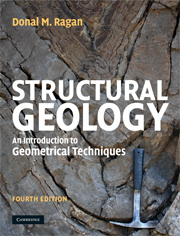Book contents
- Frontmatter
- Contents
- Preface
- Acknowledgements
- 1 Structural planes
- 2 Thickness and depth
- 3 Lines and intersecting planes
- 4 Planes and topography
- 5 Stereographic projection
- 6 Rotations
- 7 Vectors
- 8 Faults
- 9 Stress
- 10 Faulting
- 11 Deformation
- 12 Strain
- 13 Flow
- 14 Folds
- 15 Parallel folds
- 16 Similar folds
- 17 Folds and topography
- 18 Structural analysis
- 19 Tectonites
- 20 Drill hole data
- 21 Maps and cross sections
- 22 Block diagrams
- Appendices
- References
- Index
21 - Maps and cross sections
Published online by Cambridge University Press: 05 June 2012
- Frontmatter
- Contents
- Preface
- Acknowledgements
- 1 Structural planes
- 2 Thickness and depth
- 3 Lines and intersecting planes
- 4 Planes and topography
- 5 Stereographic projection
- 6 Rotations
- 7 Vectors
- 8 Faults
- 9 Stress
- 10 Faulting
- 11 Deformation
- 12 Strain
- 13 Flow
- 14 Folds
- 15 Parallel folds
- 16 Similar folds
- 17 Folds and topography
- 18 Structural analysis
- 19 Tectonites
- 20 Drill hole data
- 21 Maps and cross sections
- 22 Block diagrams
- Appendices
- References
- Index
Summary
Geological maps
A variety of structural techniques have been described in previous chapters. In the main, the approach has been one of dissecting the geological map and examining its parts. The map is, however, more than the sum of these geometrical parts, and it remains to consider some of the more collective features.
Properly done, the map is an exceedingly important tool in geology. The graphical picture it gives of the location, configuration and orientation of the rock units of an area could be presented in no other way. Essential as the map is, however, it is not without limitations, and if it is to be of maximum use these limitations must be fully understood. The most important point to realize is that geological maps generally record both observations and interpretation. In part, the element of interpretation is due to a lack of time and complete exposure; it is almost never possible to examine all parts of an area. If a complete map is to be produced, this lack of observed continuity then requires interpolation between observation points and such interpolation is, to a greater or lesser degree, interpretive.
To distinguish between observation and interpretation several devices may be adopted. Most commonly, special symbols are used to identify several degrees of certainty in the location of lithologic contacts (Fig. 21.1); additional map symbols can be found in Compton (1985, p. 372).
- Type
- Chapter
- Information
- Structural GeologyAn Introduction to Geometrical Techniques, pp. 518 - 533Publisher: Cambridge University PressPrint publication year: 2009

